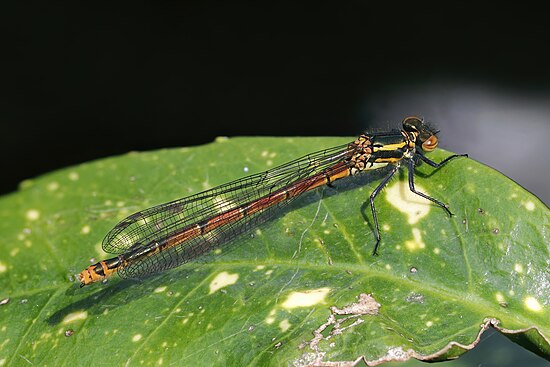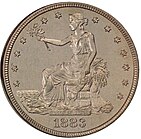From today's featured article
The trade dollar was a United States dollar coin minted to compete with other large silver coins that were already popular in East Asia. The idea first came about in the 1860s, when the price of silver began to decline due to increased mining efforts in the western United States. The Coinage Act of 1873 made trade dollars legal tender up to five dollars. The coins were first struck in 1873, and most of the production was sent to China. Eventually, bullion producers began converting large amounts of silver into trade dollars, causing the coins to make their way into American commercial channels. This frustrated payees, as the coins were traded for less than one dollar each. In response to their wide distribution in US commerce, the coins were officially demonetized in 1876, but continued to circulate. Production of business strikes ended in 1878, though the mintage of proof coins continued until 1883. The trade dollar was remonetized when the Coinage Act of 1965 was signed into law. (Full article...)
Did you know ...
- ... that the itinerant preacher Thomas Illyricus (pictured) wrote early critiques of Martin Luther based only on sources that Luther would accept?
- ... that Michael Huber's translation of Salomon Gessner's works into French made Gessner the best-known German-language poet in Europe before Goethe?
- ... that 24 Hour Psycho slows down Alfred Hitchcock's 1960 film Psycho to two frames per second, stretching its duration to a full 24 hours?
- ... that Moenadi was reportedly offered the post of Governor of Central Java during a flight?
- ... that Olivia Rodrigo wears two interlaced purple Band-Aids in the artwork for her song "Vampire"?
- ... that Peter Fallon, an Irish poet who translated Virgil's Georgics, also edited a 1970 beat-poetry magazine that featured works by John Lennon and Allen Ginsberg?
- ... that the story for Infogrames' 1992 computer game Alone in the Dark was outlined in just three days?
- ... that research conducted in 2020 found that squirrels are "nearly ubiquitous" on college campuses in the United States and Canada?
In the news
- In Brazil, the Superior Electoral Court bars former president Jair Bolsonaro (pictured) from running for political office until 2030 for abuse of power before the 2022 general election.
- Riots break out across France after a 17-year-old is fatally shot by police in Paris.
- In Russia, the Wagner mercenary group stands down after rebelling against the government.
- In China, an explosion at a restaurant in Yinchuan kills 31 people.
On this day
July 11: Day of Remembrance of the Victims of Genocide in Poland (1943)
- 1302 – Franco-Flemish War: Flemish infantry defeated a large French army near Kortrijk at the Battle of the Golden Spurs.
- 1405 – Marking the start of Ming China's treasure voyages, an expeditionary fleet led by Zheng He (depicted) set sail for foreign regions of the South China Sea and the Indian Ocean.
- 1792 – The Belfast Harp Festival, an early event in the Gaelic revival, began at the Assembly Rooms.
- 1960 – To Kill a Mockingbird, a novel by Harper Lee featuring themes of racial injustice and the loss of innocence in the Deep South of America, was published.
- 1991 – Shortly after taking off from Jeddah, Saudi Arabia, Nigeria Airways Flight 2120 caught fire and crashed, killing all 261 people on board.
- Bardaisan (b. 154)
- Kitty O'Brien Joyner (b. 1916)
- Eusebia Cosme (d. 1976)
- Satoru Iwata (d. 2015)
Today's featured picture

|
|
The large red damselfly (Pyrrhosoma nymphula) is a species of damselfly belonging to the family Coenagrionidae. Found mainly in Europe, with some populations also in northern Africa and western Asia, it inhabits small ponds, lakes and dikes, and occasionally slow-moving rivers. Large red damselflies have black legs and wing spots in both sexes, and can reach a body length of 33 to 36 millimetres (1.3 to 1.4 in). They are often the first damselflies to emerge in the spring, usually in April or May, and adults can be found until September in some localities. This female large red damselfly was photographed on Cumnor Hill in Oxfordshire, England. It is of the form fulvipes, one of three colour forms for the species. Photograph credit: Charles J. Sharp
Recently featured:
|
Other areas of Wikipedia
- Community portal – The central hub for editors, with resources, links, tasks, and announcements.
- Village pump – Forum for discussions about Wikipedia itself, including policies and technical issues.
- Site news – Sources of news about Wikipedia and the broader Wikimedia movement.
- Teahouse – Ask basic questions about using or editing Wikipedia.
- Help desk – Ask questions about using or editing Wikipedia.
- Reference desk – Ask research questions about encyclopedic topics.
- Content portals – A unique way to navigate the encyclopedia.
Wikipedia's sister projects
Wikipedia is written by volunteer editors and hosted by the Wikimedia Foundation, a non-profit organization that also hosts a range of other volunteer projects:
-
Commons
Free media repository -
MediaWiki
Wiki software development -
Meta-Wiki
Wikimedia project coordination -
Wikibooks
Free textbooks and manuals -
Wikidata
Free knowledge base -
Wikinews
Free-content news -
Wikiquote
Collection of quotations -
Wikisource
Free-content library -
Wikispecies
Directory of species -
Wikiversity
Free learning tools -
Wikivoyage
Free travel guide -
Wiktionary
Dictionary and thesaurus
Wikipedia languages
This Wikipedia is written in English. Many other Wikipedias are available; some of the largest are listed below.
-
1,000,000+ articles
-
250,000+ articles
-
50,000+ articles



